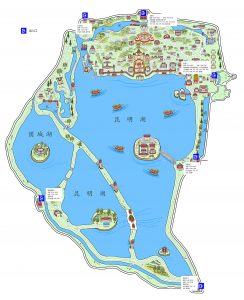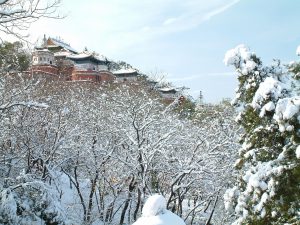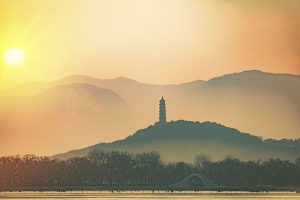The Summer Palace in Beijing
The Summer Palace, located in the western suburbs of Beijing, is the first classical garden in China. It was listed on the World Heritage list on December 2, 1998.
Composed of Longevity Hill and Kunming Lake, the whole park is set against the background of Xishan peaks, the architectural complex is integrated with the situation of mountains and lakes, and the scenery is ever-changing.
The park is divided into three areas, namely, the political activity area with Renshou Hall as the center, the Emperor’s living area with Yulan Hall and Leshou Hall as the main body, and the scenic tourist area composed of Wanshou Hill and Kunming Lake.
History

The Summer Palace, the imperial garden of the Qing Dynasty in China, formerly known as the Garden of clear ripples, is located in the western suburbs of Beijing, 15km from the urban area, covering an area of about 290ha (2.9sq km), adjacent to Old Summer Palace. It is a large-scale landscape garden based on Kunming Lake and Longevity Hill, based on the West Lake in Hangzhou and drawing on the design techniques of the gardens in the south of the Yangtze River. it is also the most well-preserved royal palace, known as the “Royal Garden Museum”. It is also a national key tourist attraction.
Before Emperor Qianlong of the Qing Dynasty succeeded to the throne, four large royal gardens were built in the western suburbs of Beijing. In the fifteenth year of Qianlong (1750), Emperor Qianlong used 4.48 million taels of silver to honor his mother and the holy queen to transform it into the Garden of clear ripples, forming a 20-kilometer-long royal garden from Tsinghua Garden to Xiangshan. In the tenth year of Xianfeng (1860), the Garden of clear ripples was burned by the Anglo-French coalition forces. Guang Xu 14 years (1888) reconstruction, renamed the Summer Palace, as a summer resort. In the 26 year of Guang Xu (1900), the Summer Palace was destroyed by the “allied forces of the eight powers” and the treasures were looted. After the fall of the Qing Dynasty, the Summer Palace was destroyed again during the period of infighting among warlords and Kuomintang rule.
On March 4, 1961, the Summer Palace was announced as the first batch of national key cultural relic protection units, together with Chengde Summer Resort, Humble Administration Garden and Liuyuan announced at the same time as the four famous gardens in China, and was listed on the World Heritage list in November 1998. On May 8, 2007, the Summer Palace was officially approved by the National Tourism Administration as a national 5A-level tourist attraction. In 2009, the Summer Palace was selected by the China World Records Association as the largest existing royal garden in China.
Architectural pattern

The Summer Palace covers an area of 293 hectares and is mainly composed of Wanshou Hill and Kunming Lake. There are more than 3000 palace gardens in various forms, which can be roughly divided into three parts: administration, life and sightseeing.
The administrative district centered on Renshou Hall was the place where Empress Dowager Cixi and Emperor Guang Xu sat and listened to the government and met with foreign guests. Behind Renshou Hall are three large quadrangles: Leshou Hall, Yulan Hall and Yiyun Hall, where Cixi, Guang Xu and imperial concubines live respectively. The Dehe Garden Theatre Building on the east side of Yiyun Hall is one of the three major theatre buildings in the Qing Dynasty.
From the sea of wisdom at the top of Wanshou Hill, the Summer Palace consists of Foxiang Pavilion, Dehui Hall, Paiyun Hall, Paiyunmen and Yunhui Yufang, forming a hierarchical axis. At the foot of the mountain is a “corridor” more than 700m long, with more than 8000 colored paintings on the girders of the corridor, known as “the first corridor in the world”. The promenade used to be Kunming Lake. The west dike of Kunming Lake is modelled on the Su dike of the West Lake.
Longevity Hill behind the mountain, Houhu ancient wood forest, there are Tibetan temples, Suzhou Creek ancient trading street. At the eastern end of the back lake, there is a small and exquisite Harmony Garden, which is built in imitation of Jichang Garden in Wuxi. It is called “the Garden in the Garden”.
Opening Hours
- Business hours: 6:30 to 1800.
- The checking time of large tickets: before 18:00.
- (Dehe Garden, Foxiang Pavilion, Suzhou Street, Wenchang Yuan) ticket checking time: 8:30 to 17:00.
How many doors are there to enter the Summer Palace?
A total of five gates of the Summer Palace are the South Ruyi Gate, the newly built Palace Gate, the East Palace Gate, the North Palace Gate and the West Palace Gate, all of which can be admitted to the hospital.
Tour Tips
how can I visit the Summer Palace with the least effort?

The summer palace has a very large area and the most energy-saving way to visit is to be admitted to the hospital in the south, from the south to the north, and finally out of the north palace gate, not far from the subway north palace gate station.
What are the highlights of the Summer Palace?
The scenic spots of the Summer Palace can be divided into Gongting District, Qianshan District, Houshan Lake District, Kunming Lake District and so on.
Imperial area
The palace district is the administrative and living area of the emperor and empress dowager of the Qing Dynasty. From Hanxu archway to the west is the square, East Palace Gate, Renshou Gate, Renshou Hall, this group of buildings constitute the main body of the administrative area. The administrative area is followed by Leshou Hall, Yulan Hall, Yiyun Pavilion and other emperors’ living areas. Dehe Garden, Dongbasu and other buildings are buildings that assist the life of emperors.
Qianshan area
The former mountain area is the most concentrated area of scenic spots in the Summer Palace. Paiyun Hall, Buddha incense Pavilion and Zhi Hai are located in the middle of Wanshou Hill and are the most symbolic buildings in the Summer Palace scenic area. The promenade is listed horizontally at the foot of Wanshou Hill, starting from the invitation Moon Gate to the Shizhang Pavilion. Qianshan has built many courtyards due to its shape, such as Yunxuan, endless Yixuan, Jieshou Hall, Qinghua Xuan, listening Hall, Yishou Hall, Yunsong Nest, etc., all kinds of pavilions and pavilions adorn the mountains, Jingfu Pavilion, Yi Chi Yun Zai, Chongcui Pavilion, mountain lakes on the first floor, the middle of the painting, the true meaning of Hu Shan are all good places to view the scenery. The Harmony Garden at the eastern foot of Wanshou Hill is built in imitation of Wuxi Qinyuan, which has the characteristics of the south of the Yangtze River. Xiao Suzhou Street in the west foot used to be a trading street, and Shifang and the shipyard are located at both ends.
Kunming Lake
The lake area behind the mountain is quiet and quiet. The four continents and the Xumi Lingjing site form a Sino-Tibetan mixed Buddhist architecture complex. Chun Spring Garden, Huacheng Pavilion, Yi Wangxuan, Gouxuxuan, watching Yunqi were all destroyed by the Anglo-French coalition forces, which are now ruins. Suzhou Street is built in imitation of Suzhou Creek Road and shop model in the south of the Yangtze River. Restored in the nineties of the 20th century, Yining Hall is an important place for the Summer Palace to display cultural relics. Xuan Qingxuan, located in the northeast corner of the Summer Palace, is a unique garden. The water surface of Kunming Lake is vast, and the South Lake Island, Zhijing Pavilion, Zaojiantang Island and the West Embankment constitute the main scenery of the lake area.
South Lake Island
The Seventeen-hole Bridge on Nanhu Island is connected to the east embankment, and the six bridges on the west embankment are of different styles. Bronze Niu is opposite to the east and west of the ploughing and weaving scenic spot. Changguan Hall in Hunan is a building to enjoy the pastoral scenery outside the garden. Xiuyi Bridge is the channel through which the long river enters the Summer Palace.
Tour time
how long does it take to visit the Summer Palace?
The area of the Summer Palace is relatively large. Generally speaking, it will take about three hours to visit the Summer Palace. There are some fast food restaurants in it. It is suggested that you prepare some simple food and drinking water by yourself. After all, the contents are a little expensive.
About ticketing
is there an electronic ticket in the Summer Palace?
The Summer Palace can buy online e-tickets in advance, and there will be a QR code after placing an order. With this QR code, you can scan the QR code directly at the ticket gate and enter the park without having to wait in line to change tickets, which is very convenient. To avoid the pain of waiting in line.
About buying tickets
What you buy online is usually a coupon, that is, you can go to all the places in the Summer Palace, 60 yuan for adults, half price discount. Only 30 yuan for ordinary tickets and 15 yuan for concessionary tickets. There are only four places in the Summer Palace that need to be charged extra. It is recommended to buy ordinary tickets, because you do not have so much energy to visit, so we went to a place that requires an extra charge, and then visit Kunming Lake. It has been used for about 4.5 hours. You don’t have to buy a map for a tour. First of all, there is a general tour direction on the ticket, and there are hints for any map software to open. The ticket is 30 yuan per person, no discount.
Tour order
Beigongmen enter the park: Beigongmen-Suzhou Street-four continents-Foxiang Pavilion-Paiyun Hall-promenade-Shifang-take a boat to Nanhu Island-Seventeen Kong Bridge-Tongniu-Kunming Lake East Embankment-Wenchang Yuan-Yulan Hall-Yi Yun Hall-Leshou Hall-Dehe Garden-Renshou Hall-East Palace Gate.









